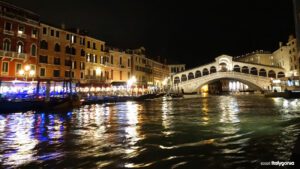The best travel experiences in Italy
Why is Venice Built Over Water?
Exploring the History and Unique Features of the Floating City
Venice, the Floating City, is one of the most iconic and visually captivating cities in the world. Its canals, historical buildings, and intricate network of islands make it a truly unique destination. But have you ever wondered why this beautiful city is built on water? Why would people choose to build a city in such an unconventional location, surrounded by a lagoon instead of solid land?
In this detailed guide, we will delve into the fascinating history and engineering marvels that led to the creation of Venice. From its ancient origins to the reasons why it thrives on water today, we’ll explore how the city came to be and why it remains one of the most remarkable cities in the world.
1. The Origins of Venice: A City of Refuge
Ancient Beginnings: From Roman Times to the Early Middle Ages
The story of Venice begins over 1,500 years ago, during the decline of the Roman Empire. The first settlements on the islands of the Venetian Lagoon can be traced back to the 5th century AD, when people sought refuge from Barbarian invasions. The Venetians, mostly farmers and fishermen from nearby mainland areas, fled to the lagoon to escape the violence and chaos on the mainland.
The Strategic Location of the Lagoon
The Venetian Lagoon was an ideal location for the settlers. Its waters were shallow, with numerous islands, providing a natural defense against invaders. The complex system of islands and waterways made it difficult for enemies to navigate and easily attack the city. This made Venice a perfect safe haven for its early inhabitants.
Early Construction: Building on Water
In the early days, the Venetians used the existing islands to build their homes. However, as the population grew, the need for more land became apparent. Instead of moving to higher ground, the Venetians ingeniously found ways to build structures on water. They created a system of wooden pilings, driven deep into the lagoon’s mud, which served as the foundation for the buildings.
The Role of the Wooden Piles
The construction of Venice’s foundations is one of its most fascinating aspects. The Venetians drove thousands of wooden piles, primarily made from cedar and oak, into the soft, marshy soil beneath the water. Over time, these wooden piles became incredibly durable due to the anaerobic (oxygen-free) environment of the lagoon. The preservation of the wood in this environment allowed the city to stay intact for centuries.
2. The Development of Venice: From a Refuge to a Maritime Power
The Rise of the Venetian Republic
By the 9th century, Venice had become a powerful maritime republic. The Venetian Republic (also known as La Serenissima) controlled vast territories and became a major trading hub between the East and West. The city’s strategic location on the lagoon allowed it to control access to the Adriatic Sea, which was crucial for trade, military defense, and political influence.
Venice’s Growth and Expansion
As Venice grew in wealth and influence, so did its need for more space. The canals that wound through the city became essential for transportation and trade. The city’s unique structure, built on water, allowed for the canal-based transport of goods, while the waterways also served as natural boundaries between neighborhoods.
Engineering Marvels: The Development of Foundations
As Venice expanded, the engineering techniques used to build on water also advanced. The Venetians continued to drive wooden piles into the lagoon, but they began using more complex methods to ensure stability. Over time, the city’s foundations became stronger through the construction of stone platforms and the use of concrete, allowing for the building of larger and more impressive structures.
3. The Challenges of Building a City on Water
The Problem of Rising Water Levels: Acqua Alta
One of the most significant challenges faced by Venice is the issue of rising water levels, or acqua alta. Due to its location in a lagoon, Venice is particularly vulnerable to changes in sea level. Over the centuries, rising tides, combined with land subsidence, have caused the city to sink gradually into the lagoon.
The Impact of Climate Change
In recent years, climate change has exacerbated the problem of rising sea levels. Global warming has led to the melting of polar ice caps and the expansion of seawater, causing Venice to experience more frequent flooding events. The city’s unique position on water means that it is especially susceptible to the effects of climate change, with some areas of the city experiencing regular flooding during the winter months.
The MOSE Project: Venice’s Solution to Rising Waters
To combat the effects of rising sea levels, Venice has undertaken ambitious engineering projects like the MOSE Project. This initiative involves the construction of large barriers that can be raised to protect the city from high tides and storm surges. While the MOSE Project has faced delays and controversies, it represents a significant effort to safeguard Venice’s future in the face of climate change.
4. Venice’s Urban Layout: A City Built Around Canals
The Canal System: Venice’s Lifeblood
Venice’s canals are one of the key features that make it so unique. The city is crisscrossed by narrow waterways, which serve as the primary means of transport. The most famous of these canals is the Grand Canal, a wide waterway that runs through the center of the city. The Grand Canal is lined with historic palaces, churches, and buildings that reflect the city’s rich history.
A City Without Cars
Unlike most cities around the world, Venice does not have roads for motorized vehicles. Instead, the canals function as the city’s streets. Gondolas, vaporettos, and water taxis are the primary forms of transport, creating a peaceful and picturesque atmosphere. This car-free lifestyle is a significant part of Venice’s charm and appeal to visitors.
The Bridges of Venice
The bridges of Venice are essential for connecting the islands and navigating between the city’s neighborhoods. There are over 400 bridges in Venice, each with its own unique design and history. Some of the most famous bridges include the Rialto Bridge, Accademia Bridge, and Ponte dei Sospiri (Bridge of Sighs). These bridges allow pedestrians to easily cross from one side of the canal to the other and add to the city’s distinctive architectural style.
5. The Cultural and Architectural Significance of Venice’s Water-Based Foundation
Venice’s Unique Architecture
The architecture of Venice is one of the most distinctive aspects of the city. Over the centuries, Venetian architects and builders have created structures that reflect the city’s water-based foundation. The Venetian Gothic style is characterized by pointed arches, delicate stonework, and large windows that allow for maximum light in the buildings. These architectural features were not only beautiful but also practical, ensuring that the buildings remained stable in the challenging environment of the lagoon.
Palaces and Churches: Structures Built on Water
The palaces and churches of Venice are masterpieces of Venetian architecture. The city’s most famous landmark, St. Mark’s Basilica, features Byzantine-inspired mosaics and domes that create a stunning visual effect. The Doge’s Palace is another iconic building, combining Gothic and Renaissance styles to create a symbol of Venice’s political power and wealth.
Venetian Art and Culture: A Legacy of Water-Based Living
The unique environment of Venice has also influenced the city’s art and culture. Venetian painters, such as Titian and Tintoretto, were inspired by the city’s waterways and the play of light on the water. The city’s art galleries and museums house an incredible collection of works that reflect Venice’s maritime history and its position as a crossroads between East and West.
6. The Future of Venice: Preserving the Floating City
Venice’s Enduring Legacy
Venice is a city unlike any other in the world. Its water-based foundation, historic canals, and remarkable architecture have made it a UNESCO World Heritage Site and a popular tourist destination. However, the challenges that Venice faces—such as rising sea levels, acqua alta, and environmental threats—are very real. The city’s future will depend on ongoing efforts to preserve its unique structure and adapt to the changing climate.
Sustainability and Preservation Efforts
The preservation of Venice is a priority for both the city’s government and international organizations. Efforts are underway to promote sustainable tourism, reduce environmental damage, and invest in flood protection measures. However, maintaining Venice’s beauty and charm requires a delicate balance between modernization and conservation.
Conclusion
Venice is a city like no other, built on water and steeped in history. From its origins as a refuge from invaders to its rise as a maritime power, Venice’s unique foundation on the Venetian Lagoon has shaped its culture, architecture, and way of life. As we continue to witness the impacts of climate change and rising sea levels, Venice faces significant challenges, but it remains an enduring symbol of human ingenuity, resilience, and beauty. Understanding why Venice was built over water is key to appreciating the magic and mystery of this remarkable city.
Book your Venice private tour
You might also be interested in:
Cose da Fare a Venezia: La Guida Completa per Esplorare la Città sull’Acqua
Le Migliori 10 Cose da Vedere a Venezia
Guida Turistica Venezia: Scopri la Magia di una delle Città più Belle del Mondo
Come mai Venezia è stata costruita sull’acqua?
Venice and its Lagoon – UNESCO World Heritage Centre



